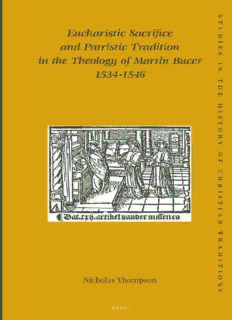
Eucharistic Sacrifice And Patristic Tradition In The Theology Of Martin Bucer 1534-1546 (Studies in the History of Christian Thought) PDF
Preview Eucharistic Sacrifice And Patristic Tradition In The Theology Of Martin Bucer 1534-1546 (Studies in the History of Christian Thought)
EUCHARISTIC SACRIFICE AND PATRISTIC TRADITION IN THE THEOLOGY OF MARTIN BUCER, 1534-1546 STUDIES IN THE HISTORY OF CHRISTIAN TRADITIONS FOUNDED BY HEIKO A. OBERMAN † EDITED BY ROBERT J. BAST, Knoxville, Tennessee IN COOPERATION WITH HENRY CHADWICK,Cambridge SCOTT H. HENDRIX, Princeton, New Jersey BRIAN TIERNEY,Ithaca, New York ARJOVANDERJAGT,Groningen JOHN VAN ENGEN, Notre Dame, Indiana VOLUME CXIX NICHOLAS THOMPSON EUCHARISTIC SACRIFICE AND PATRISTIC TRADITION IN THE THEOLOGY OF MARTIN BUCER, 1534-1546 EUCHARISTIC SACRIFICE AND PATRISTIC TRADITION IN THE THEOLOGY OF MARTIN BUCER, 1534-1546 BY NICHOLAS THOMPSON BRILL LEIDEN•BOSTON 2005 Cover illustration: Priest offering the sacrifice of the Mass on behalf of the people. From Gherit van der Goude, Dat Boexken van der Missen(Antwerp: Adriaen van Berge, 1507) This book is printed on acid-free paper. Library of Congress Cataloging-in-Publication Data Thompson, Nicholas, 1965- Eucharistic sacrifice and patristic tradition in the theology of Martin Bucer, 1534-1546 / by Nicholas Thompson. p. cm. — (Studies in the history of Christian traditions, ISSN 1573-5664 ; v. 119) Includes bibliographical references and index. ISBN 90-04-14138-3 1. Bucer, Martin, 1491-1551. 2. Lord’s Supper—Sacrifice—History of doctrines—16th century. I. Title. II. Series. BV823.T46 2005 234’.163’092—dc22 2004054596 ISSN 1573-5664 ISBN 90 04 14138 3 © Copyright 2005 by Koninklijke Brill NV, Leiden, The Netherlands Koninklijke Brill NV incorporates the imprints Brill Academic Publishers, Martinus Nijhoff Publishers and VSP. All rights reserved. No part of this publication may be reproduced, translated, stored in a retrieval system, or transmitted in any form or by any means, electronic, mechanical, photocopying, recording or otherwise, without prior written permission from the publisher. Authorization to photocopy items for internal or personal use is granted by Brill provided that the appropriate fees are paid directly to The Copyright Clearance Center, 222 Rosewood Drive, Suite 910 Danvers, MA 01923, USA. Fees are subject to change. printed in the netherlands Tomyparents whofirst madehistoryandtheologyfascinating This page intentionally left blank CONTENTS Acknowledgements ................................................... xi Key toAbbreviations................................................. xiii . Introduction........................................................ 3 . The PlaceofTraditioninthe Debateonthe Sacrifice ofthe Mass................................................................ 17 . Introduction..................................................... 17 . TheAuthorityofTraditionontheEveof theReformation .. 21 .. Humanism asa ComplicatingFactor..................... 25 . TheEarlyDebateontheSacrificeoftheMass .................. 33 . Introduction..................................................... 33 . TheProtestant Critique ........................................ 34 .. TestamentumetPromissio...................................... 34 .. The OpusOperatumand itsApplicationtoOthers......... 35 . TheCatholicResponse......................................... 41 .. Sacrificium.................................................... 44 .. SacramentumSacrificii......................................... 49 .. The OpusOperatumand itsApplicationtoOthers......... 56 .. TheHistoricalDevelopment oftheMass................. 63 .. TheMemorialoftheFaithfulDepartedandtheSaints.. 67 . TheReformers’Use ofPatristicTestimony intheDebateon theMass............................................................ 73 . Introduction..................................................... 73 . TheReformers’ Use oftheFathers intheDebateonthe SacrificeoftheMass............................................ 75 .. Questioning theAuthenticityoftheAuthorities.......... 75 .. Sacrificium.................................................... 76 .. SacramentumSacrificii......................................... 81 .. TheApplicationof theMass .............................. 85 .. ThePrivateMass .......................................... 87 .. TheCanon................................................. 88 . Summary: Eucharistic Sacrifice andTraditioninthe Early Reformation..................................................... 89 . Bucer’sEarly Writingonthe Mass(–)................... 93 . Introduction..................................................... 93 .. TheAbolitionoftheMassinStrasbourg ................. 93 .. From theAbolitionof theMasstotheEarly s....... 101 . Bucer’sEarly CritiqueoftheMass............................. 104 .. The Mutilationofthe Divine Institutionofthe Sacrament.................................................. 104 .. TheEthicaland EcclesiologicalDimensions ofthe Eucharist.................................................... 105 .. The Statusofthe Church’sLiturgicalTradition.......... 110 ... ChristianFreedomandtheInner andOuter Dimensions ofChristian Worship .................. 110 ... TheEucharistic-SacrificialTradition............... 112 TheRomanCanon..................................... 112 TheLegitimacy of LaterAdditions totheDominical Institution........................................... 113 TheEucharistic-Sacrifical Vocabulary of theFathers...... 115 TheCatholicProof-Texts ............................... 116 TheIndefectibilityofthe Church......................... 123 . Bucer’sPreparationsforaCouncil(–) .................. 127 . Introduction..................................................... 127 . EvolutionoftheIdeaofa ReligiousColloquy................. 128 .. EpistolaApologetica ().................................... 128 .. FurbereytungzumConcilio()and Berichtaussder heyligenGeschrift ()....................................... 131 .. DefensioadversusAxioma Catholicum() ................... 140 .. The FlorilegiumPatristicum(c. )andConsilium Privatim Conscriptum(c.)................................ 141 . CatholicIrenic WritingontheSacrificeoftheMass (–)......................................................... 145 . Introduction..................................................... 145 . Augsburg :theCommitteeoftheFourteen............... 145 . Erasmus ......................................................... 148 . Georg Witzel.................................................... 149 . Johannes Gropper............................................... 154 . TheColloquiesand the Mass(–)........................ 167 . TheSecond ColloquyofLeipzig()........................ 167 . TheSecret ColloquyofWorms ()andtheFirst ColloquyofRegensburg() ................................. 172 .. Introduction................................................ 172 .. ArticleFourteen:The Sacrament ofthe Eucharist ....... 176 .. ArticleTwenty: CertainDogmasConfirmed bythe AuthorityoftheChurch................................... 180 ... TheSacrificeoftheMass........................... 183 TheFirst Offering:Christ............................... 183 TheSecondOffering:TheChurch ....................... 189 TheThirdOffering:Praise ............................. 195 TheFourthSacrifice: BreadandWine................... 196 TheCanonof theMass................................. 198 .. ArticleTwenty-one: OntheAdministrationofthe Sacraments and CertainSpecificCeremonies............ 200 . Summary: TheMassintheEra oftheColloquies............ 205 . TheAftermathoftheFirst ColloquyofRegensburg (–) ......................................................... 209 . Introduction..................................................... 209 . TheReformationatCologne .................................. 209 .. EinfaltigesBedenken/PiaacSimplexDeliberatio() ....... 211 .. Gegenberichtung/Antididagma ()......................... 212 .. BestendigeVerantwortung/ConstansDefensio() ........... 213 .. DeVeraetFalsaCaenaeDominicaeAdministratione () ..... 213 . ThePrinciples Underlying theDebate ........................ 216 . Eucharistic SacrificeinConstans Defensio()and DeVeraet FalsaCaenae DominicaeAdministratione ()........................ 225 . Introduction..................................................... 225 . TheStructureoftheDebate ................................... 225 . CausaOfferendi:theRationaleofSacrifice ...................... 226 . TheFourSacrifices oftheMass................................ 232 .. The Offering ofBreadand Wine ......................... 233 .. TheOffering ofChrist..................................... 238 .. TheOffering oftheChurch............................... 254
Description: